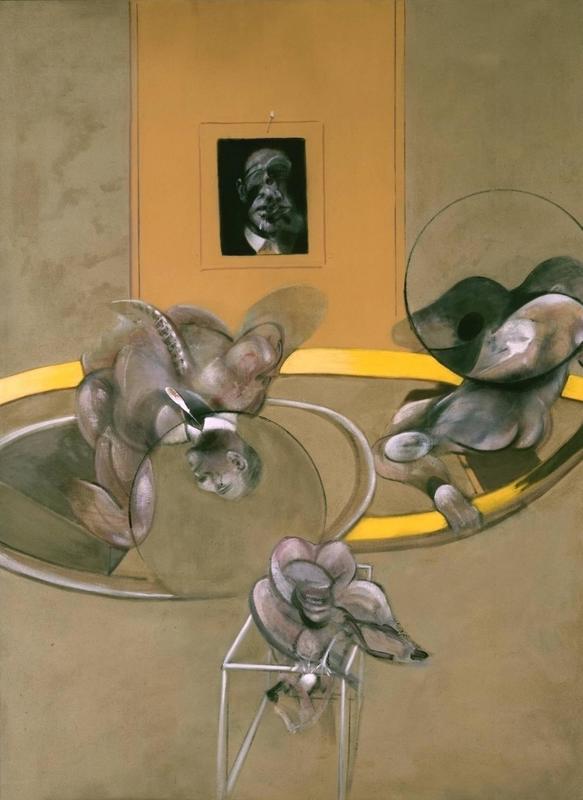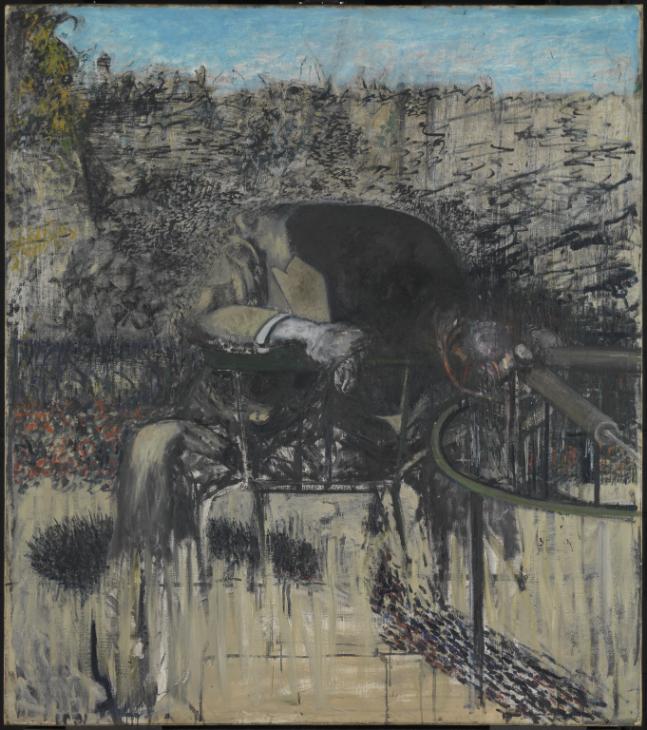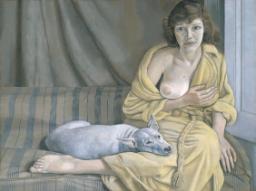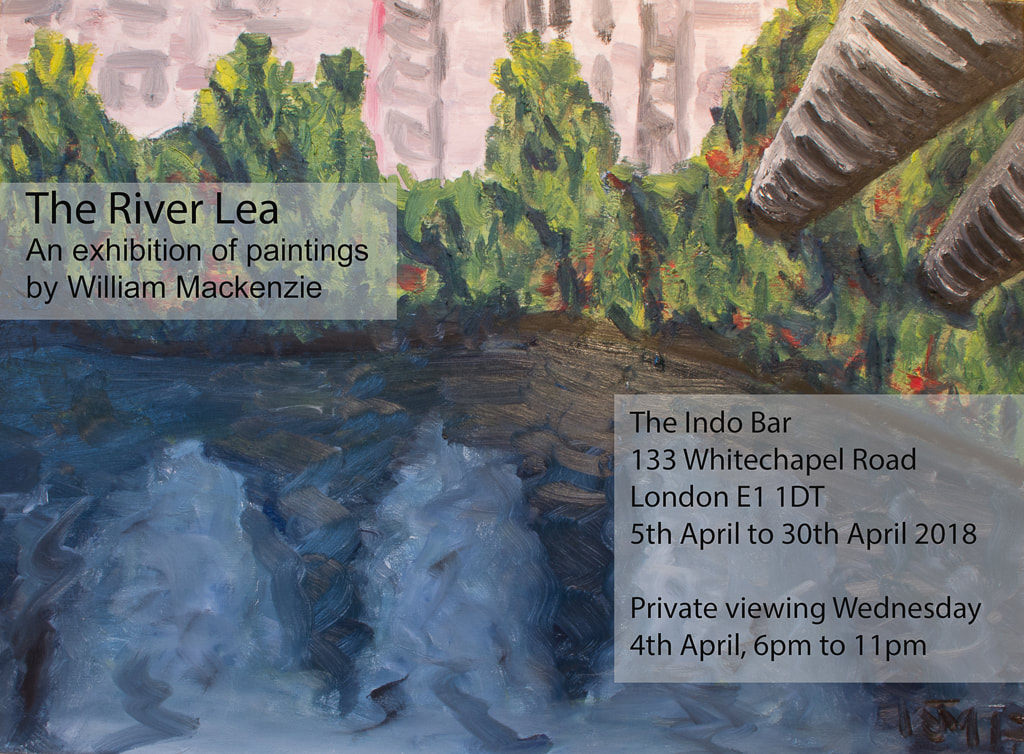|
There is a monster show at Tate Britain with the evocative title of All Too Human and features the giants of mainly Britain from the 20th century such as Freud, Bacon, Andrews and others. It stretches across 11 rooms and there is a large number of paintings on display. As with all such good shows it also introduces you (well me anyway) to people you haven’t heard of or are less familiar with. A good example of this is the artist who opens the show , Stanley Spencer and his direct and fierce portrait of Patricia Pearce, one nude, one clothed. Unlikely “classic” nude there is a genuine personality here and the person looks out at you from the canvas. David Bomberg is a favourite of mine and there is allot of his work in this show including an interesting early self portrait and a landscape, Toledo from the Alahambra with the builts marked by thick swipes of paint. For some reason although this is a predominately 20th Century British artist Soutine makes an appearance with both a very striking portrait but also a mad dynamic landscape called Landscape of Ceret. It is crusty colourful and dynamic. In fact it fits in the show quite well as it shares a number of similarities with both Bomberg and later Kossof and Auerbach. The second room contains Francis Bacon, quite a number of them and all ones I hadn’t seen. The most striking of which is called simply Figure in a Landscape a sort of twisted horrific black figure in a scrabbly distorted landscape (above). As with most Bacon pictures at least for me, it is unique and interesting but actually deeply unpleasant to look at. More subtle was a Study for a portrait after William Blake in which against a dark background is depicted a semi translucent ghostly head. The next room was entirely filled with an artist I had never heard of called F N Souza. His style was very different from everyone else in the show but I have to say it really appealed to me. Some of it such as the Crucifixion reminded me of Basquiat with the spiky silouhetish figures. He presents these very stylised figures with thick outlines, makes them monstrous but not inhuman. My favourite of these was Jesus and Pilatus with the scoring through the paint to form the beard and the hair and the shiny paint. His landscapes have a similar quality such as Citadel which looks like some kind of insect hive or an abstract stained glass window painting over a mottled blue background. William Coldstream’s paintings are as formal as the name would imply. He has this thing of marking up the paintings using a grid to get a very exact representation. You therefore get what is supposedly an objective image. What lifts them up from being too cold though is that the cross marks in blue, black and red used to mark points on the image are left visible or semi visible, an artefact that appealed to me. He was a fan of Freud and in the same room as Coldstream is what I think is the best of one Freuds painting, woman with cat. Bomberg makes a reappearance in a room that serves basically as a counterpoint to the exact realism of Coldstream et al in the previous room. The room flows from Bomberg to Auerbach and Kossof (the later two of which are still a live, now in their late 80s, Auerbach had his own show last year). There is a soft and dreamy landscape of the City of London. Next to this is a similarly styled portrait by Dorothy Mead of a reclining figure, all soft focus with no solid features but a sort of gloomy impressionism. Auerbach is next up. I prefer Auerbach when he is slightly more restrained in his application of lots of glopy paint. I find his crustier paintings a bit repellent, the remind me of the next in the Aliens film. So Park Village East, which is more restrained and colourful has a greater value to me at least. Kossof occupies some of the same room, there is a very interesting piece in black and white (or rather blue and white) but my favourite was Demolition of the Old House which is done with swathes of green, red and blue all scraped over. Freud features again with a room of his own, including an insanely detailed plant and flower painting which apparently took him three years to paint. The technical brilliance and attention to detail in all his paintings is astonishing but I find his paintings very cold and devoid of emotion. So for example there is a nude female figure, in classic pose eyes averted from the viewer. Contrast this with his portrait of David and Eli (Eli is a dog), also a nude but there is an obvious genuine affection for the sitter who has a personality and stares directly at you, and also a similar portrait of Freud's first wife (above). Bacon is next up and again its horrific twisted figures often against raw canvas, all distorted and strange. The best of these was, I thought, a portrait of Lucien Freud (above), reclined in what looks like a pool hall on a Green Baize sofa, with the body swirly and the face distorted (if you like Bacon you will probably also like the author Jeff Vandermeer, they chime a similar cord with me). Moving on you have a room of Michael Andrews (who I have written about before) and another new discovery R B Kitaj. I like Michael Andrews and of the three works on display my favourite is a very sweet picture called Melanie and I Swimming (above) which shows the painted swimming with his daughter. It is a very personal piece. I particularly like the water which reminded me of Peter Doig (another favourite of mine). R B Kitaj on the other hand shouts at you with bright colours and riotous scenes (like the one above). He was a new name to me and I again had three works on display I preferred the calmer To live in Peace which was narrow and rectangular with blocks of pastel colour, with one characters skirt is just a stencil flower on a white field. The figures are possibly singing and are all blurry as if in motion. Paula Rego (above) is a name that chimed a slight bell and for reasons that are obscure had a room to herself. She has a thing for oversized heads which I have heard compared to children’s illustrations. I particularly like the surreal fairy tale like tryptic on the back wall. The final room contains contemporary female artists, three of whom particularly appealed to me. Celia Paul in a self portrait called Artist and Model. It has shades of Giacometti with this slightly elongated grey figure wearing a scrapy artists smock which is covered in flecks of paint. Her face is expressive (if a little overworked) and glum).
Cecily Brown works in colour and nature and has a particular gift for playing on the slightly hidden. Of her two works Teenage Wildlife was the best in my view. You have bright colourful foliage obscuring, but not entirely, two semi naked forms. Hampstead Heath in May was my immediate thought. As you exit you are flanked by Lynette Yiadom- Boakye (above). According to the blurb she can create these in a day in which case this makes her annoyingly talented and prolific. As the two I preferred the one on the left, sadly I have forgotten the name but it is three figures, each one turning slightly further away from you. They look like dancers and particularly effective is the reflection in the wet pavement. This is a seriously seriously good show. This is one of the few shows I am considering going again. You should definitely go. You’ve got time as it on until 27th August. I shall sign off with some self publicity. I have a solo show (I'm very excited) at the Indo Bar in Whitechapel, starting on 4th April and running until the end of the month. Come and have a look. Tell me what you think.
0 Comments
Leave a Reply. |
Archives
June 2024
Categories |










 RSS Feed
RSS Feed